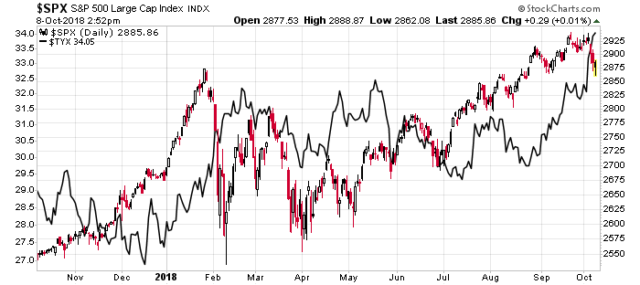One of the “elephants hiding in plain sight” in 2018 was how the market reacted in February 2018 during the volatility crash:
This chart takes a few seconds to mentally digest, but the key point is that during the beginning of February, the correlation between the 30-year treasury bond yield and the S&P 500 decoupled. Normally market crashes have the tendency of having investors flow capital into long-term treasuries as a safety valve but this did not occur.
What’s happened over the past week is that the 30-year treasury yield has spiked 20bps from roughly 3.2% to 3.4% and the S&P 500 has edged down during that time period. While the equity moves were relatively low (within the bounds of regular volatility), it is increasingly evident that long-term government treasury bonds are no longer being regarded by the market as a haven of safety.
If/when the markets decide to crash, it is quite likely that long-dated treasury bonds will be crashing at the same time and cash/short duration will be the only safe haven when this occurs.
Canadian interest rates are also creeping up as well.
There are going to be bargains here and there, but in general, most investors are going to face some serious headwinds going forward. Cash is king in these situations.

If you want to know when a crash is imminent, just call me. If I am 75% or more invested then there will be a minimum 10% correction. If I am 75% or more in cash the bullls are in control.
(XLI), (XLK),
(XLY),(XLF).
So what is your percentage invested fraction now? If your track record is correct I’m worried you might jump off a bridge!
RRSP about 90% TFSA 50% cash account. 25% invested
I think this a pullback before the traditionally strongest Quarter Nov Dec Jan
But I’ll get my jumping shoes on just in case. What are your current allocations.
Unchanged from my Q3-2018 update although a bit poorer today than on September 30th!
So 6% cash